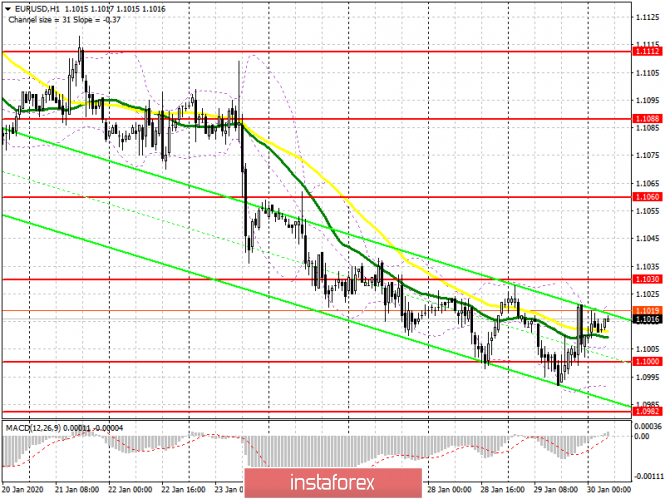To open long positions on EURUSD you need:
Yesterday's meeting of the Federal Reserve was fairly calm, and the results coincided with the expectations of market participants, which did not make it possible for the US dollar to continue to strengthen against the euro. At the moment, the bulls have the task of overcoming the resistance of 1.1030, and it depends only on this level whether the pair will continue to grow further and whether the downward trend will be broken. Consolidation above 1.1030 will lead to the renewal of highs in the region of 1.1060, but a larger bullish impulse is formed only if the data indicates an increase in consumer sentiment in the eurozone and a good state of the labor market. Do not forget about the report on the growth of the US economy at the end of last year, the release of which is scheduled for the afternoon. With the option of pulling down the pair in the morning, you can still return to long positions after the formation of a false breakout in the support area of 1.1000, but I recommend buying the euro immediately for a rebound only after updating the lows of 1.0982 and 1.0964.
To open short positions on EURUSD you need:
Yesterday, bears coped with the task of updating support for 1.1000, but failed to close the trading day below this range, which indicates an active rebuff from buyers of the euro. The bulls took advantage of weak statistics on the US economy and the Fed's decision, which fully coincided with the forecasts of economists, which led to the recovery of EUR/USD in the afternoon. The task of euro sellers today is to form a false breakout in the resistance area of 1.1030, which will be the first signal to open short positions. Consolidation below the level of 1.1000 will push the pair to the lows of 1.0982 and 1.0964, where I recommend taking profits. In the EUR/USD growth scenario above the resistance of 1.1030, short positions are best postponed until the highs of 1.1060 are updated, or sell immediately for a rebound in the resistance area of 1.1088.
Signals of indicators:
Moving averages
Trade is conducted in the region of 30 and 50 moving average, which indicates the formation of a side channel in the short term.
Bollinger bands
A break of the upper boundary of the indicator in the region of 1.1020 will lead to an increase in demand for the euro. Support will be provided by the lower boundary in the area of 1.0990.

Description of indicators
- Moving average (moving average determines the current trend by smoothing out volatility and noise). Period 50. The graph is marked in yellow.
- Moving average (moving average determines the current trend by smoothing out volatility and noise). Period 30. The graph is marked in green.
- MACD indicator (Moving Average Convergence / Divergence - moving average convergence / divergence) Fast EMA period 12. Slow EMA period 26. SMA period 9
- Bollinger Bands (Bollinger Bands). Period 20
